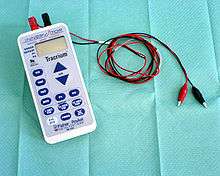Neuromuscular monitoring
In anesthesia, Neuromuscular monitoring, also known as train of four monitoring, is a technique used during recovery from the application of general anesthesia to objectively determine how well a patient's muscles are able to function. It involves the application of electrical stimulation to nerves and recording of muscle response using, for example, an acceleromyograph. Neuromuscular monitoring is typically used when neuromuscular-blocking drugs have been part of the general anesthesia and the doctor wishes to avoid postoperative residual curarization (PORC) in the patient, that is, the residual paralysis of muscles stemming from these drugs.
When train of four monitoring is "used continuously, each set (train) of stimuli normally is repeated every 10th to 12th second. Each stimulus in the train causes the muscle to contract, and 'fade' in the response provides the basis for evaluation." These sets are called trains because their shape bears the semblance of a train.[1] In train of four monitoring, "peripheral nerve stimulation can ensure proper medication dosing and thus decrease the incidence of side effects" by "assessing the depth of neuromuscular blockade".[2]
Before the patient is fully awake, voluntary muscle testing is not possible and indirect clinical tests, such as apparent muscle tone and pulmonary compliance, can be affected by factors other than PORC. Direct neuromuscular monitoring avoids these problems and allows the doctor to remedy PORC before it becomes a source of patient distress.[3][4][5][6][7]



References
- ↑ "Train-of-Four Stimulation". Churchill Livingstone. 2000. Retrieved 10 September 2014.
- ↑ "Peripheral Nerve Stimulator - Train of Four Monitoring". Medscape. 12 July 2013. Retrieved 10 September 2014.
- ↑ Viby-Mogensen, Jorgen. "Neuromuscular Monitoring" (PDF). Retrieved 7 March 2013.
- ↑ Harvey AM, Masland RL: Actions of durarizing preparations in the human. Journal of Pharmacology And Experimental Therapeutics, Vol. 73, Issue 3, 304-311, 1941
- ↑ Botelho SY: Comparison of simultaneously recorded electrical and mechanical activity in myasthenia gravis patients and in partially curarized normal humans. Am J Med. 1955 Nov;19(5):693-6. PMID 13268466
- ↑ Christie TH, Churchill-Davidson HC: The St. Thomas's Hospital nerve stimulator in the diagnosis of prolonged apnoea. Lancet. 1958 Apr 12;1(7024):776. PMID 13526270
- ↑ Engbaek J, Ostergaard D, Viby-Mogensen J: Double burst stimulation (DBS): a new pattern of nerve stimulation to identify residual neuromuscular block. Br J Anaesth. 1989 Mar;62(3):274-8. PMID 2522790
Further reading
- Hemmerling TM, Le N (Jan 1960). "Brief review: Neuromuscular monitoring: an update for the clinician". Can J Anaesth. 54 (1): 58–72. doi:10.1007/BF03021901. PMID 17197470.